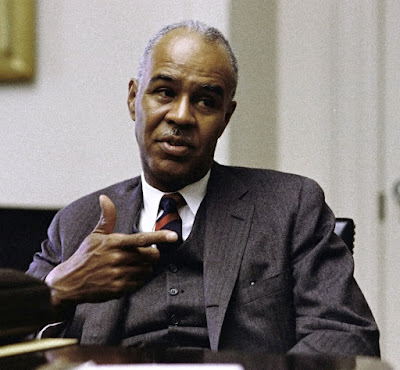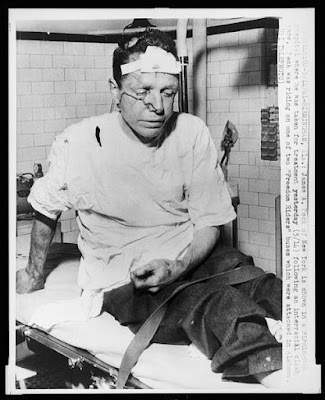In 1963, the United States was in racial unrest. Nationwide outrage was sparked by media coverage of police actions in Birmingham, Alabama, where attack dogs and fire hoses were turned against protesters, many of whom were in their teens or younger. Martin Luther King, Jr., was arrested and jailed during these protests, writing his famous letter from Birmingham City Jail, which advocates civil disobedience against unjust laws. Dozens of additional demonstrations took place across the country, from California to New York, leading up to the March on Washington for Jobs and Freedom.
The March on Washington represented a coalition of several civil rights organizations, all of which generally had different approaches and different agendas. The "Big Six" representatives were James Farmer, of the Congress of Racial Equality (CORE); Martin Luther King, Jr., of the Southern Christian Leadership Conference (SCLC); John Lewis, of the Student Nonviolent Coordinating Committee (SNCC); A. Philip Randolph, of the Brotherhood of Sleeping Car Porters; Roy Wilkins, of the National Association for the Advancement of Colored People (NAACP); and Whitney Young, Jr., of the National Urban League.
President John F. Kennedy originally discouraged the march for fear that it might make Congress vote against civil rights laws in reaction to a perceived threat. Once it became clear that the march would go on, however, he supported it. Various labor unions also supported the march.
Outright opposition came from two sides: white supremacist groups, who were obviously not in favor of any event supporting racial equality, and some civil rights activists who felt it presented an “inaccurate, sanitized pageant of racial harmony;” Malcolm X called it the "Farce on Washington".
On August 28, 1963, an estimated quarter of a million people, about a quarter of whom were white, marched from the Washington Monument to the Lincoln Memorial, in what turned out to be both a protest and a communal celebration. Some travelling from the South were harassed and threatened on the way to the march. The heavy police presence turned out to be unnecessary, as the march was civil and peaceful. The march was extensively covered by the media, with live international television coverage.

Bayard Rustin was instrumental in organizing the march. He hired off-duty police officers as marshals, bus captains to direct traffic, and scheduled the podium speakers. In his closing remarks, Rustin stated the demands of the march were “the passage of meaningful civil rights legislation; the elimination of racial segregation in public schools; protection for demonstrators against police brutality; a major public-works program to provide jobs; the passage of a law prohibiting racial discrimination in public and private hiring; a $2 an hour minimum wage; and self-government for the District of Columbia”, which had a black majority.
The event included musical performances by Marian Anderson; Joan Baez; Bob Dylan; Mahalia Jackson; Peter, Paul, and Mary; and Josh White. Charlton Heston; representing Harry Belafonte, Marlon Brando, Diahann Carroll, Ossie Davis, Sammy Davis Jr., Lena Horne, Paul Newman, and Sidney Poitier; read a speech by James Baldwin.
The speakers included all of the "Big Six" civil-rights leaders (James Farmer, who was imprisoned in Louisiana at the time, had his speech read by Floyd McKissick); Catholic, Protestant, and Jewish religious leaders; and labor leader Walter Reuther. The one female speaker was Josephine Baker, who introduced several "Negro Women Fighters for Freedom," including Rosa Parks.
The two most noteworthy speeches came from John Lewis and Dr. Martin Luther King, Jr. Lewis and the SNCC were a younger, more radical group than Dr. King's. The speech he planned to give, circulated beforehand, was objected to by other participants; it called Kennedy's civil rights bill "too little, too late," asked "which side is the federal government on?" and declared that they would march "through the Heart of Dixie, the way Sherman did" and "burn Jim Crow to the ground, nonviolently." In the end, he agreed to tone down his speech, but even the
revised version was still strong, stating:
“They’re talking about slow down and stop. We will not stop. All of the forces of Eastland, Barnett, Wallace, and Thurmond will not stop this revolution. If we do not get meaningful legislation out of this Congress, the time will come when we will not confine our marching to Washington. We will march through the South; through the streets of Jackson, through the streets of Danville, through the streets of Cambridge, through the streets of Birmingham. But we will march with the spirit of love and with the spirit of dignity that we have shown here today. By the force of our demands, our determination, and our numbers, we shall splinter the segregated South into a thousand pieces and put them together in the image of God and democracy. We must say: “Wake up America! Wake up!” For we cannot stop, and we will not and cannot be patient.”
Dr. King's speech is one of the most famous speeches in American history. He started with prepared remarks, saying he was there to "cash a check" for "Life, Liberty and the pursuit of Happiness," while warning fellow protesters not to "allow our creative protest to degenerate into physical violence. Again and again, we must rise to the majestic heights of meeting physical force with soul force." But then he departed from his script, shifting into the "I have a dream" theme he'd used on prior occasions, drawing on both "the American dream" and religious themes, speaking of an America where his children "will not be judged by the color of their skin but by the content of their character." He followed this with an exhortation to "let freedom ring" across the nation, and concluded with:
“And when this happens, when we allow freedom to ring, when we let it ring from every village and every hamlet, from every state and every city, we will be able to speed up that day when all of God's children, black men and white men, Jews and Gentiles, Protestants and Catholics, will be able to join hands and sing in the words of the old Negro spiritual, ‘Free at last, free at last. Thank God Almighty, we are free at last.’”
The March is credited with propelling the US government into action on civil rights, creating political momentum for the Civil Rights Act of 1964 and the Voting Rights Act of 1965. The cooperation of a Democratic administration with the issue of civil rights marked a pivotal moment in voter alignment within the US. The Democratic Party gave up the Solid South, its undivided support since Reconstruction among the segregated Southern states, and went on to capture a high proportion of votes from blacks from the Republicans.







